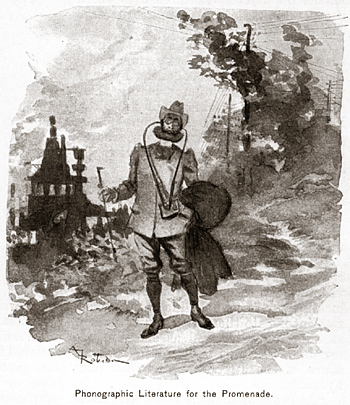
Book bindings are often what captivates bibliophiles, and Uzanne carried this concern for surfaces to other topics besides books, such as fashion. Not sure if this category covers the charmingly titled 1879 work Le bric-à-brac de l'amour. I am not aware of an English translation for that, but one of his books was translated, as The Sunshade, the Glove, the Muff (1884) . And, again with the surfaces, we learn something of feline pelts here, rather than pets.
...... Under Charles IX. the simple citizen folk were only allowed to wear black Muffs; ladies of the highest condition had alone a right to sumptuous Muffs of various colours.
In a satiric print of 1634, signed Jaspar Isac, and entitled The Squire de la Mode, we see carried by a woman, who is accompanied on foot by a Gascon cavalier, the first French Muff having a direct relation with that which is still in use at the present day. It is a sheath of stuff or silk bordered on both sides by a thick white fur, which grows into an enormous roll at the ends.
But it is amongst the precious engravings of Hollar, Abraham Bosse, Arnoult, Sandrart, Bonnard, and Trouvain that we see the authentic Muff really born, and find it in the hands of the Parisian matron, of the lady of quality in her winter dress, of the Precieuse, and the coquetting flirt. An engraving of Bonnard shows us a great lady .... in court dress, on the point of going out; a waiting-maid adjusts her mantle, and a gentleman attends the beauty's good pleasure; the Muff she carries was then of a moderate size, with a bow in the middle. The Muff was worn for style, "for grace," and was made of sable-marten for ladies of the Court, and simply of dog-skin or cat-skin for the small citizens' wives who could not devote more than fifteen to twenty francs to the acquisition of this light hand-warmer.
Antoine Furetiere, in his Dictionary, has condensed in a few lines all the materials of a Dissertation on the Muff of the seventeenth century. At the word Muff we read:—
A fur worn in winter, in which to put the hands, to keep them warm. Muffs were formerly only for. women: at the present day they are carried by men. The finest Muffs are
made of marten the common of miniver... the country Muffs of the cavaliers are made of otter and of tiger. ..... A little Muff-dog is a little dog which ladies can carry in their Muff.
Octave Uzanne. The article we link to is worth visiting.
No comments:
Post a Comment